I’ve learned the hard way that keeping great people isn’t about free pizza Fridays or fancy slogans on the wall. It’s about building an environment where your team actually wants to stay because they see growth, respect, and balance in the work you offer. When you get it wrong, turnover doesn’t just hurt morale: it drains cash, slows execution, and leaves you constantly rebuilding instead of scaling.
You’ll see better results if you stop treating retention like an HR checklist and start treating it like a leadership discipline. The strategies I’m about to share aren’t theory. They’re moves I’ve seen work in real companies: compensation structures that actually compete, feedback loops that don’t die in spreadsheets, flexible work setups that cost nothing but earn loyalty.
Consider this guide a toolkit. Each section gives you one lever: what it is, how to pull it, and an example of it working in practice. By the end, you’ll have 14 proven strategies you can adapt to your team without guesswork, and without wasting another quarter on “engagement ideas” that don’t move the needle.
What Are Employee Retention Strategies?
Employee retention strategies are the practical steps you take to make people want to stay. Not gimmicks, not surface perks, but the everyday systems that convince someone this is the right place to build their career.
At its heart, retention answers a simple question: why should a talented employee choose to stay when other offers are waiting? The answer usually comes down to a mix of fair pay, growth opportunities, respect, flexibility, and recognition.
Strong retention isn’t about one-off fixes. It’s about weaving habits into how you lead. That could mean putting career paths in writing, running surveys that lead to real changes, or giving managers the tools to support their teams better.
When you treat retention as an investment, you stop reacting to turnover and start preventing it. The payoff is obvious: lower hiring costs, faster execution, and a culture that compounds because people stick around long enough to make it stronger.
If you’re pressed for time, don’t try to overhaul everything at once. Start with the area that hurts most — pay, growth, flexibility, or feedback — and fix that first. Then build from there.
Why Employees Leave
When someone resigns, it’s easy to chalk it up to “better pay elsewhere” or “personal reasons.” But in reality, departures are rarely that simple. Employees leave when the environment no longer meets their needs — financial, professional, or personal. As leaders, we have to look beneath the surface. Every resignation is a signal that something in the system isn’t working. Understanding these signals is the first step to building a culture where people want to stay.
The most common reasons include:
- Inadequate pay and benefits — compensation that doesn’t match effort or market standards.
- Lack of growth opportunities — unclear career paths or stalled progression.
- Poor management — weak communication, lack of respect, or inconsistent leadership.
- Burnout and work‑life imbalance — workloads and expectations that erode energy and trust.
Here are the top employee retention strategies for you to quickly scan in case you are short on time:
| Strategy | Core Focus | Essence |
|---|---|---|
| 1. Competitive Compensation & Benefits | Fair pay and strong benefits | Benchmark salaries, audit benefits, add financial flexibility, and communicate the total package clearly |
| 2. Flexible Work Options & Work-Life Balance | Flexibility as baseline | Define hybrid/remote rules, staggered hours, compressed weeks, measure output, not attendance |
| 3. Transparent Communication & Two-Way Feedback | Listening and acting | Town halls, anonymous surveys, close feedback loops, train managers for regular constructive feedback |
| 4. Strong Management & Respectful Culture | Leadership quality | Train managers in empathy and skills, set communication standards, recognize contributions, and create a safe feedback culture |
| 5. Career Growth & Development Opportunities | Visible future | Map career paths, offer training, encourage growth talks, and support lateral moves |
| 6. Recognition & Rewards Systems | Consistent appreciation | Build recognition programs, tie rewards to contributions, mix monetary and non-monetary rewards, and peer recognition |
| 7. Employee Engagement & Team Building | Connection and energy | Organize team-building, cross-functional collaboration, track engagement, and train managers to spot disengagement |
| 8. Health & Wellness Initiatives | Protecting energy | Provide mental health resources, wellness stipends, encourage breaks, and run resilience workshops |
| 9. Work Environment & Infrastructure | Comfortable, supportive spaces | Ergonomic tools, clean and welcoming office, remote stipends, and reliable digital infrastructure |
| 10. Strong Onboarding & Integration Programs | Confident beginnings | Structured onboarding roadmap, mentors/buddies, accessible documentation, regular 90-day check-ins |
| 11. Diversity, Equity & Inclusion (DEI) | Belonging and fairness | Audit hiring/pay/promotion, bias training, support employee resource groups, and integrate DEI goals into leadership |
| 12. Clear Mission & Purpose Alignment | Meaningful work | Define mission simply, connect team goals, share impact stories, and reinforce purpose in onboarding and updates |
| 13. Employee Autonomy & Empowerment | Ownership and trust | Delegate decisions, encourage experimentation, recognize initiative, and document empowered roles |
| 14. Exit Interviews & Continuous Improvement | Learning from departures | Standardize exit interviews, capture feedback, analyze trends, share insights, and act quickly |
Now that you’ve seen the full list, let’s break each one down. We’ll start with the foundation: compensation and benefits. If you don’t get this right, no amount of culture or perks will convince people to stay.
Strategy 1: Competitive Compensation & Benefits
Why It Matters
Compensation is the baseline of retention. If employees feel underpaid or undervalued, no amount of culture or perks will convince them to stay. Fair pay and solid benefits are the foundation on which every other strategy rests.
What To Do
- Benchmark salaries against your industry and region at least once a year.
- Audit benefits, such as health insurance, PTO, retirement plans, and wellness perks.
- Add financial flexibility, like on-demand pay, profit-sharing, tuition reimbursement, or buying back unused sick days.
- Communicate clearly and ensure employees understand the full value of their package, not just the base salary.
Example in Practice: A mid-sized tech company reduced turnover by introducing on-demand pay and buying back unused sick days. It costs less than constant rehiring and sent a clear message: we value your time and financial security.
Action Checklist
[ ] Compare your pay bands with industry averages
[ ] Review PTO and sick leave policies for fairness
[ ] Add at least one financial perk that supports employees’ real lives
[ ] Share a transparent breakdown of total compensation with your team
Pro Tip: You’ll see better results if you treat compensation as a living system, not a one-time fix. Build a habit of reviewing pay and benefits annually, and adjust before employees feel the need to look elsewhere.
I learned early that once you pay fairly, the conversation shifts. People stop worrying about survival and start asking how work fits into their lives. That’s where flexibility becomes the real differentiator.
Strategy 2: Flexible Work Options & Work-Life Balance
Why It Matters
Flexibility is no longer a perk. It’s a baseline expectation. When employees can shape work around their lives, they stay longer and perform better. Without it, burnout creeps in, and turnover follows.
What To Do
- Identify which roles truly require office presence and which don’t.
- Set clear rules for hybrid or remote work, so employees know what’s allowed.
- Build flexibility into schedules: staggered hours, compressed weeks, or part-time options where possible.
- Train managers to measure output, not attendance.
Example in Practice: A consulting firm introduced staggered start times to reduce commuting stress. Employees could begin anytime between 7 and 10 a.m. Productivity stayed steady, but satisfaction scores rose sharply because people felt trusted to manage their own day.
Action Checklist
[ ] Map roles into “onsite essential” and “flexible eligible” categories
[ ] Write down your hybrid or remote policy so it’s predictable
[ ] Pilot one flexible scheduling option for a quarter and measure results
[ ] Coach managers to track deliverables instead of hours worked
When employees feel trusted to manage their time, they relax into the work. The next challenge is making sure they also feel heard. Without genuine communication, even the most flexible setup falls flat.
FREE. All Features. FOREVER!
Try our Forever FREE account with all premium features!
Strategy 3: Transparent Communication & Two-Way Feedback
Why It Matters
Employees don’t leave companies where they feel heard. Silence or one-way communication creates frustration and mistrust. When feedback flows both ways and leaders act on it, employees see that their voice has weight, and that builds loyalty.
What To Do
- Hold regular town halls or team check-ins where employees can raise issues openly.
- Use anonymous surveys to surface concerns people might hesitate to share directly.
- Close the loop: respond to feedback with clear actions or explanations.
- Train managers to give constructive feedback frequently, not just during annual reviews.
Example in Practice: A growing startup introduced quarterly “Ask Me Anything” sessions with the CEO. Employees submitted questions anonymously, and leadership answered them live. The sessions revealed issues early, built trust, and reduced turnover because people felt their concerns weren’t ignored. For deeper dives, I spin up a short survey and track how feedback shifts over the quarter. It keeps conversations grounded in data instead of assumptions. Here’s how it looks:
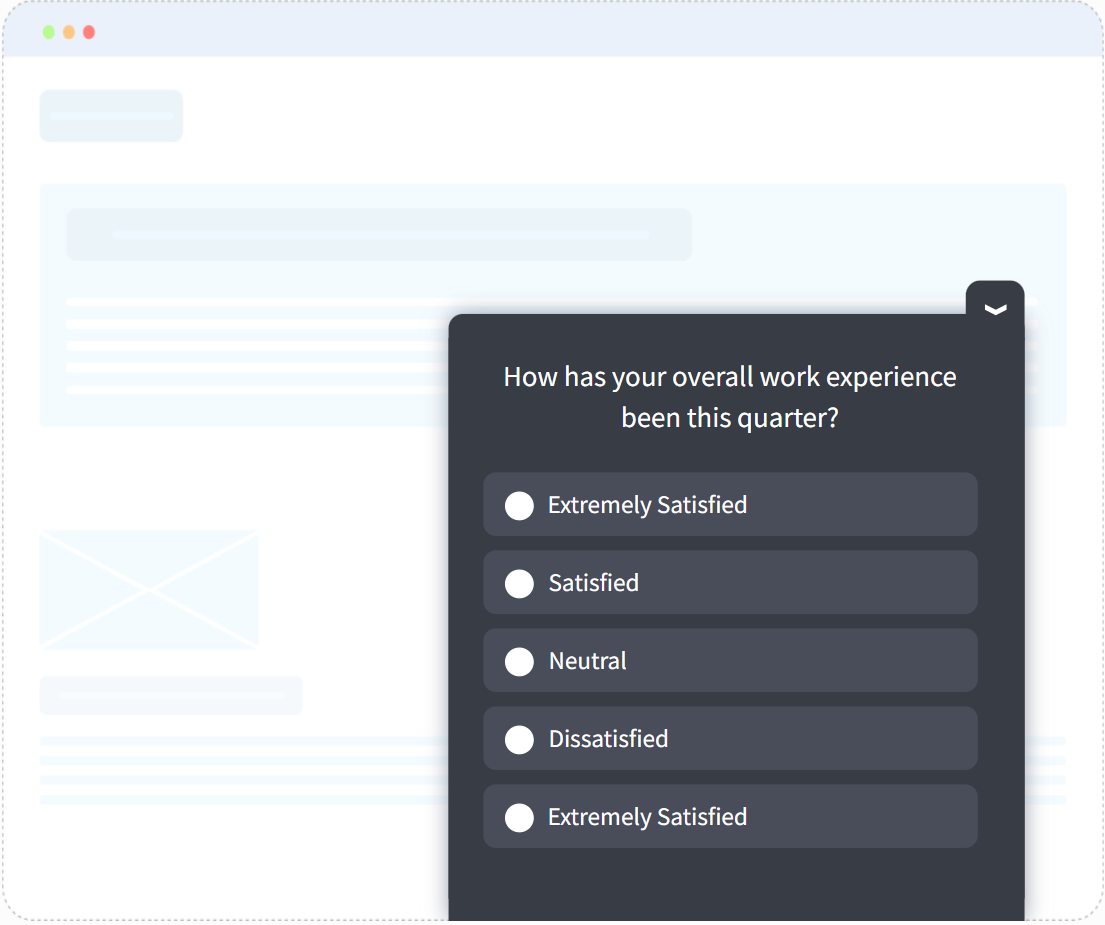
Action Checklist
[ ] Schedule recurring forums for open communication
[ ] Launch anonymous surveys and share results transparently
[ ] Document feedback and track actions taken in response
[ ] Coach managers to deliver feedback weekly, not yearly
Feedback only matters if the people leading know how to act on it. Strong managers turn words into action, and that is what builds respect. Let’s talk about how to strengthen leadership.
Strategy 4: Strong Management & Respectful Culture
Why It Matters
People often leave managers, not companies. I have seen teams walk away from solid pay and benefits simply because their manager did not respect them. Strong leadership and a culture of respect are not extras; they are the foundation that keeps people motivated and loyal.
What To Do
- Train managers in both people skills and technical skills. A brilliant operator who cannot lead will drive talent out.
- Set clear expectations for how leaders communicate and hold them accountable when they fall short.
- Encourage managers to recognize contributions regularly and fairly. Even a simple acknowledgment can build trust.
- Create an environment where employees can challenge ideas safely and share feedback upward.
Example in Practice: One company paired every new manager with a mentor for their first year. The mentorship focused on listening, conflict resolution, and building trust. Within twelve months, employee surveys revealed increased confidence in leadership, and turnover rates declined across all departments.
Action Checklist
[ ] Audit manager performance using team feedback, not just output metrics
[ ] Provide leadership training focused on empathy and communication
[ ] Establish a code of conduct that reinforces respect at every level
[ ] Create mentorship or coaching programs for new managers
I cannot stress this enough: if your managers are weak, no strategy will save you. Fix leadership first. Once you do, you’ll notice something powerful: employees stop asking “what’s next outside” and start asking “what’s next here.” That is where career growth comes in, & it is the next piece of the puzzle.
Strategy 5: Career Growth & Development Opportunities
Why It Matters
Employees stay when they can see a future for themselves inside the company. Growth opportunities provide people with a reason to invest their energy here, rather than looking elsewhere.
What To Do
- Map out career paths for each role so progression is evident.
- Offer training programs that build both technical and leadership skills.
- Encourage managers to have regular development conversations, in addition to performance reviews.
- Support lateral moves as much as promotions to broaden skills and experience.
Example in Practice: A SaaS company introduced quarterly “growth talks” where managers discussed career goals with each team member. They paired this with access to online training modules. Within a year, internal mobility increased, and employees reported higher confidence in their future at the company.
Action Checklist
[ ] Document career paths for key roles
[ ] Provide access to training and development platforms
[ ] Schedule quarterly growth conversations between managers and employees
[ ] Encourage lateral moves to broaden skills and experience
I have seen talented people leave simply because they couldn’t picture their next step with us. Once we started showing them a roadmap, retention improved almost overnight. Growth is proof that staying is worth it.
Strategy 6: Recognition & Rewards Systems
Why It Matters
People want to know their work is seen. Recognition is not about grand gestures; it is about consistency. When employees feel valued, they are more likely to stay engaged and committed.
What To Do
- Build a system for regular recognition, both formal and informal.
- Tie rewards to specific contributions so they feel earned.
- Mix monetary rewards with non-monetary ones like extra time off or public appreciation.
- Encourage peer-to-peer recognition to create a culture of appreciation across the team.
Example in Practice: A mid-sized agency introduced a monthly “spotlight award” where peers nominated colleagues for going above and beyond. Winners received a small bonus and public recognition in company meetings. The program boosted morale and created a culture where appreciation became routine.
Action Checklist
[ ] Establish a recognition program with clear criteria
[ ] Balance financial rewards with meaningful non-financial perks
[ ] Create opportunities for peer-to-peer recognition
[ ] Celebrate wins publicly to reinforce culture
I underestimated recognition early on. Once we started celebrating small wins, the energy in the company shifted. People want to feel seen, and when they do, they give more of themselves to the work.
FREE. All Features. FOREVER!
Try our Forever FREE account with all premium features!
Strategy 7: Employee Engagement & Team Building
Why It Matters
Engagement is the difference between employees who show up and employees who care. When people feel connected to their team and the company’s mission, they bring energy that no paycheck alone can buy.
What To Do
- Organize regular team-building activities that go beyond surface-level fun.
- Create opportunities for cross-functional collaboration so employees build relationships outside their immediate teams.
- Encourage managers to check in on engagement, not just performance.
- Use engagement surveys to track how connected employees feel and act on the results.
Example in Practice: A fintech startup introduced monthly “innovation days” where cross-functional teams worked on passion projects. The initiative sparked creativity, built stronger bonds across departments, and gave employees a sense of ownership in shaping the company’s future.
Action Checklist
[ ] Plan quarterly team-building activities with clear goals
[ ] Encourage cross-functional projects to strengthen collaboration
[ ] Track engagement through surveys and follow up with action. Here’s a template that you can tweak and use for employee engagement:
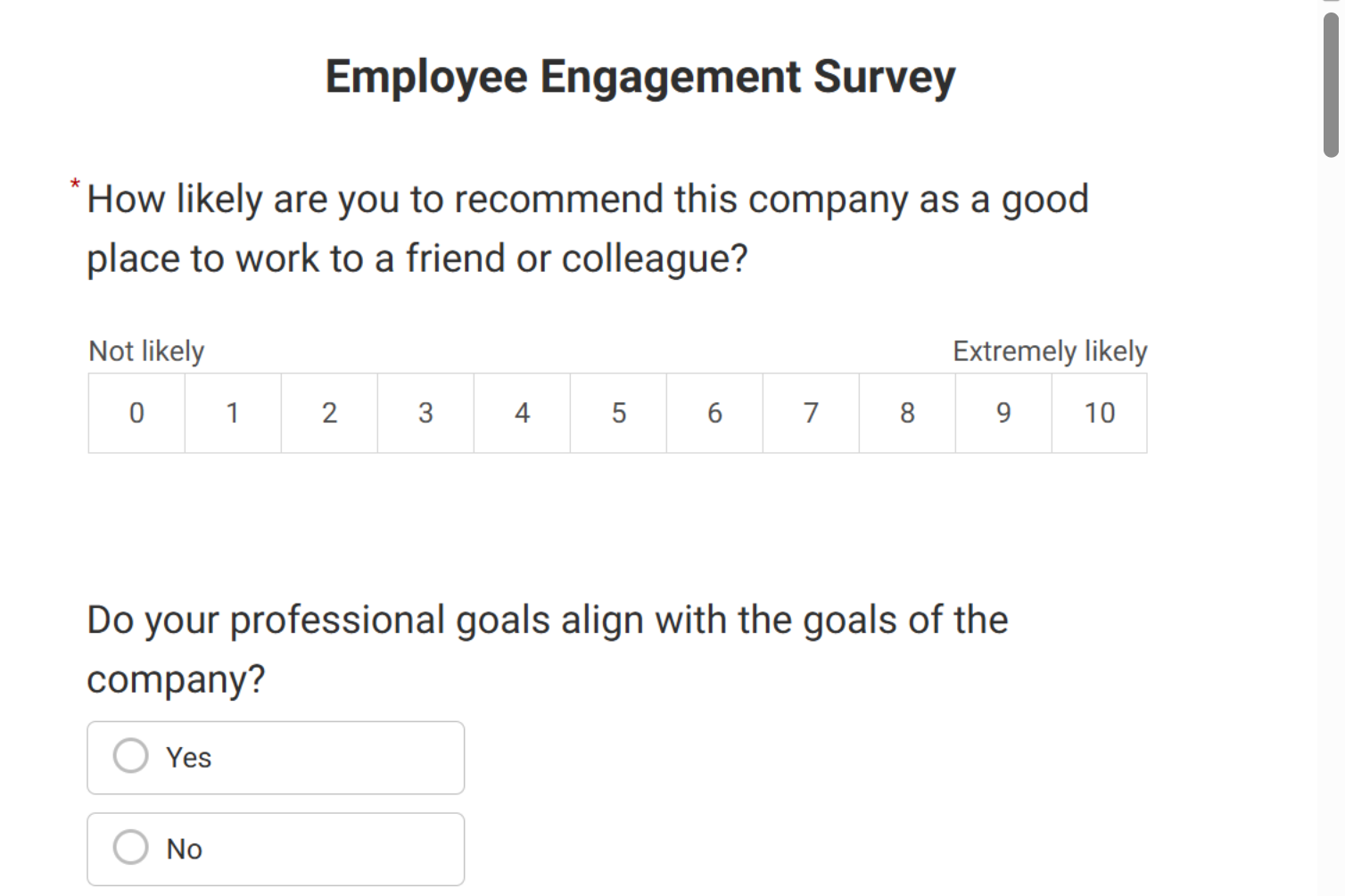
[ ] Train managers to recognize signs of disengagement early
I have seen teams transform when engagement becomes intentional. It is not about pizza parties or off-sites. It is about creating moments where people feel part of something bigger than themselves.
Strategy 8: Health & Wellness Initiatives
Why It Matters
Work takes a toll, even on the most driven people. If you ignore health and wellness, you end up with burned‑out employees who eventually walk away. Supporting physical and mental well‑being is not just about perks; it is about protecting the energy that keeps your company moving.
What To Do
- Offer wellness programs that go beyond gym memberships, including mental health resources and counseling.
- Provide healthy food options in the office or stipends for remote employees.
- Encourage breaks and time off, and make sure leaders model this behavior.
- Run workshops on stress management, mindfulness, or resilience.
- You can survey your employees to see if they are liking, or even aware of, the health and wellness programs the company offers. If you’re not sure whether your wellness programs are actually helping, run a quick check-in survey.
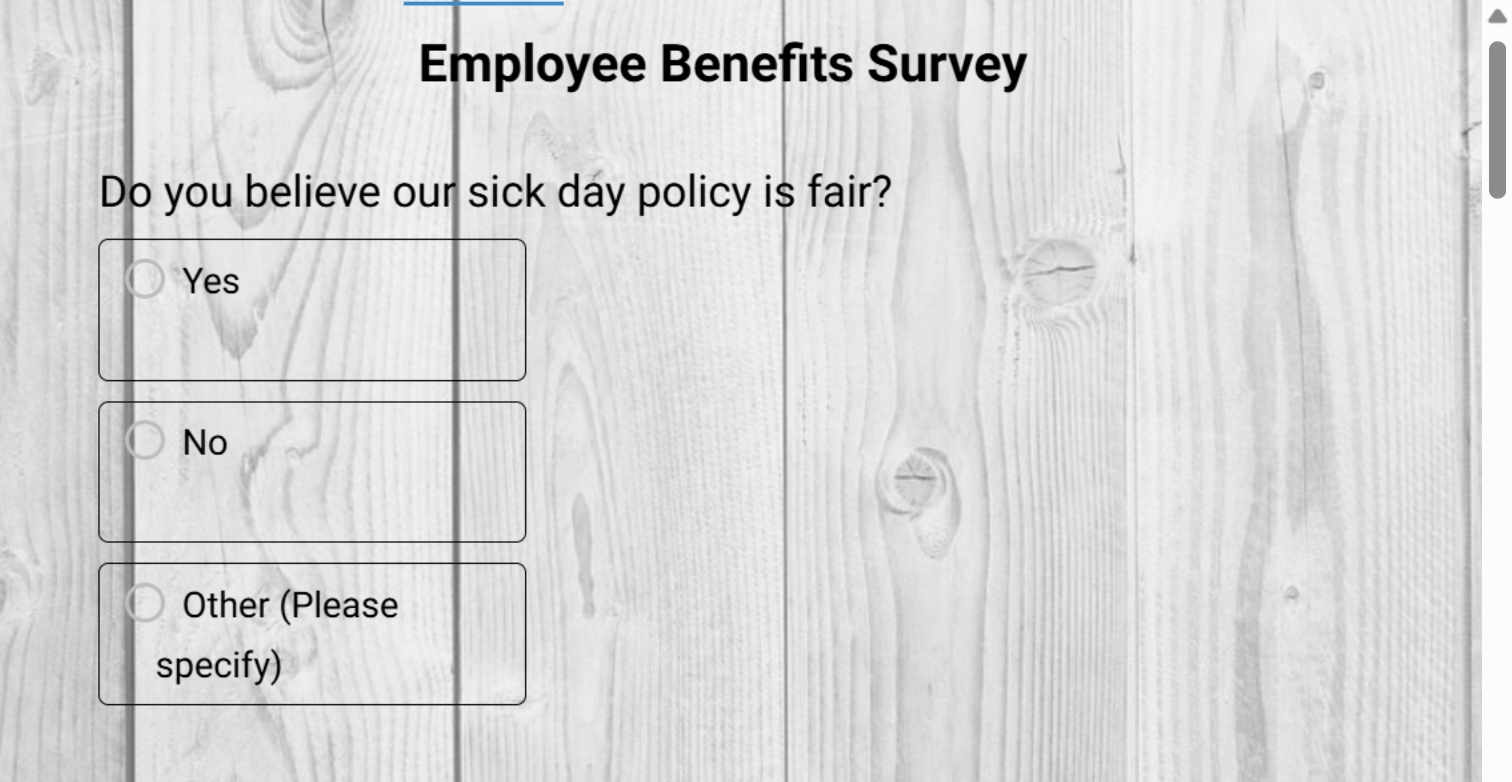
Example in Practice: A design agency introduced weekly mindfulness sessions and gave employees access to confidential counseling services. Within months, stress levels reported in surveys dropped, and employees said they felt more supported by leadership.
Action Checklist
[ ] Provide access to mental health and counseling resources
[ ] Offer wellness stipends or healthy food options
[ ] Encourage leaders to model healthy work habits
[ ] Run regular workshops on stress and resilience
I used to think wellness was a “nice to have.” Then I watched a top performer burn out and leave. That was the wake‑up call. When you invest in wellness, you are not just helping employees — you are protecting the future of your company.
Strategy 9: Work Environment & Infrastructure
Why It Matters
The space people work in shapes how they feel about the job. A cluttered, outdated, or uncomfortable environment drains energy. When the workplace is designed with care, whether physically or digitally, employees feel supported and take pride in being part of it.
What To Do
- Invest in ergonomic furniture and tools that reduce strain.
- Keep the office clean, well-lit, and welcoming.
- For remote teams, provide stipends for home office setups.
- Ensure digital infrastructure is reliable: fast internet, secure systems, and collaboration platforms that actually work.
Example in Practice: A growing startup gave every remote employee a small budget to upgrade their home office. Some bought ergonomic chairs, others invested in better monitors. The gesture signaled respect for their comfort, and employees reported higher satisfaction with their daily work setup.
Action Checklist
[ ] Audit office spaces for comfort and functionality
[ ] Provide stipends for remote employees to improve home offices
[ ] Maintain reliable digital tools and systems
[ ] Create a welcoming environment that reflects company culture
I have seen the difference a few changes have made. When people feel comfortable and equipped, they stop fighting their surroundings and start focusing on the work that matters.
Strategy 10: Strong Onboarding & Integration Programs
Why It Matters
The first days at a company set the tone for everything that follows. If onboarding is rushed or unclear, employees feel lost and disconnected. A strong integration program builds confidence, belonging, and momentum from day one.
What To Do
- Design a structured onboarding plan that covers culture, tools, and role expectations.
- Pair new hires with mentors or buddies to guide them through the first months.
- Provide clear documentation and resources so employees can find answers quickly.
- Check in regularly during the first 90 days to address challenges early.
Example in Practice: A logistics company created a 30-60-90-day onboarding roadmap. Each new hire had a mentor, access to a knowledge base, and scheduled check‑ins with leadership. The program reduced early attrition and helped employees feel part of the team faster.
Action Checklist
[ ] Build a structured onboarding roadmap with milestones
[ ] Assign mentors or buddies to new hires
[ ] Provide accessible documentation and resources
[ ] Schedule regular check‑ins during the first 90 days. Here is a quick template you can use for your first check-in after the onboarding:
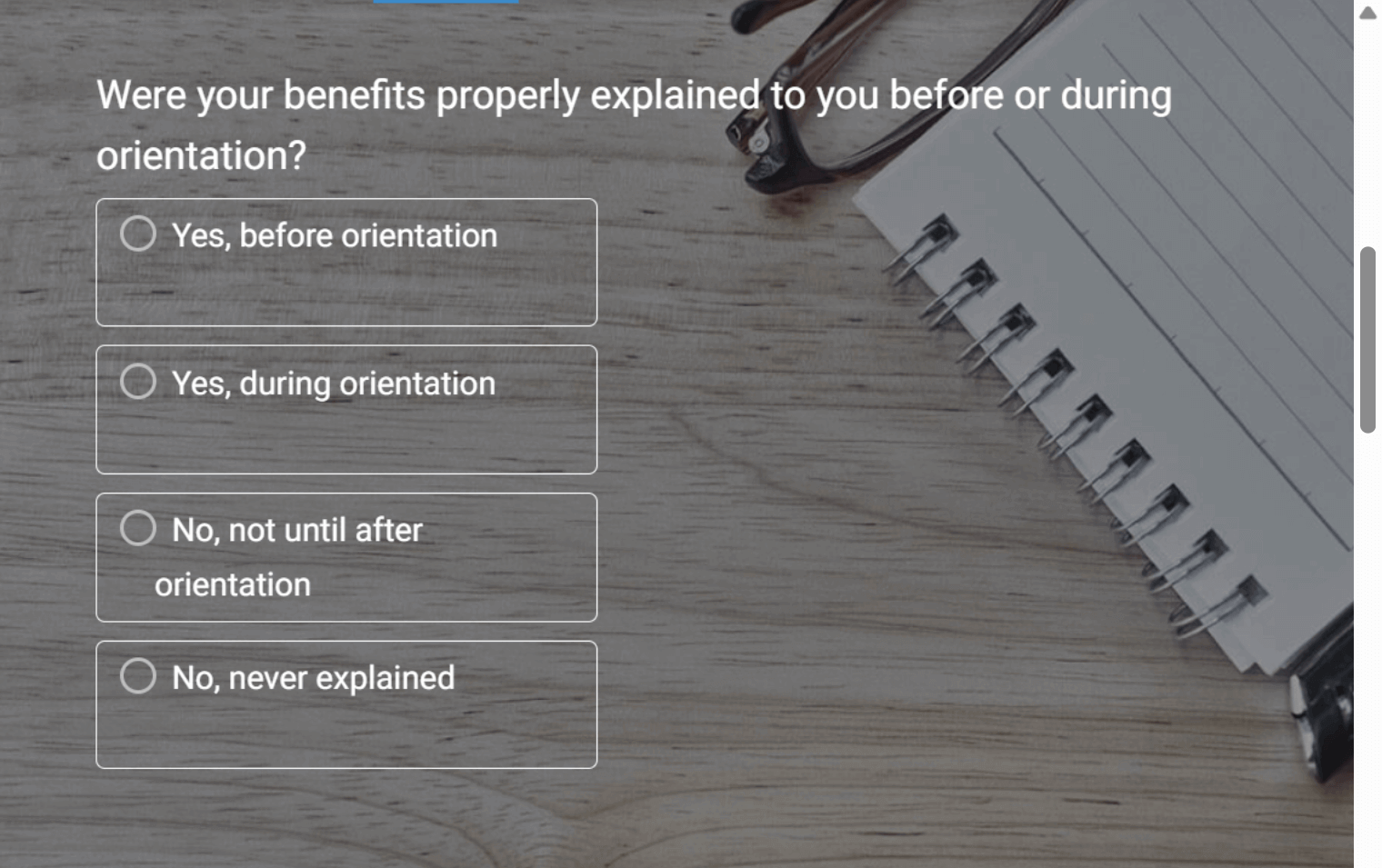
I have seen how fragile the first impression can be. When onboarding is strong, employees settle in quickly and start contributing with confidence. When it is weak, they question whether they made the right choice. The difference is night and day.
FREE. All Features. FOREVER!
Try our Forever FREE account with all premium features!
Strategy 11: Diversity, Equity & Inclusion (DEI)
Why It Matters
A company that overlooks diversity and equity will struggle to retain talent. People want to belong to workplaces where they feel respected, represented, and valued. DEI is not a checkbox exercise. It is about building a culture where every employee sees themselves as part of the story.
What To Do
- Review hiring practices to ensure diverse candidate pools.
- Train managers and teams on unconscious bias and inclusive leadership.
- Create employee resource groups that provide a platform for underrepresented voices.
- Audit pay and promotion data to identify inequities and correct them.
Example in Practice: A global services firm launched employee resource groups for women, LGBTQ+ employees, and minority communities. These groups not only created safe spaces but also influenced company policies. Retention improved because employees felt the company was listening and acting.
Action Checklist
[ ] Audit hiring, pay, and promotion practices for fairness
[ ] Provide training on bias and inclusive leadership
[ ] Support employee resource groups with funding and visibility
[ ] Build DEI goals into leadership performance reviews
I realized that culture is defined by who feels included. When people see that their identity is respected and their voice matters, they stop questioning whether they belong. That sense of belonging is what keeps them here.
Strategy 12: Clear Mission & Purpose Alignment
Why It Matters
Employees want to know why their work matters. A clear mission gives meaning to the day-to-day and connects individual effort to something bigger. When people feel aligned with purpose, they stay because they believe in what they are building.
What To Do
- Define your mission in simple, memorable language.
- Communicate how each team’s work ties back to that mission.
- Share stories that illustrate the impact your company is making.
- Reinforce purpose during onboarding and major company updates.
Example in Practice: A healthcare startup made its mission visible by sharing patient success stories during all-hands meetings. Employees saw the direct impact of their work, which strengthened their connection to the company’s purpose and reduced attrition.
Action Checklist
[ ] Write down a clear, concise mission statement
[ ] Connect team goals to the larger mission in regular updates
[ ] Share real stories that show the mission in action
[ ] Reinforce purpose during onboarding and milestones
I have seen the difference between a team chasing tasks and a team chasing purpose. When people believe in the mission, they bring energy you cannot manufacture. Purpose is what turns a job into a calling.
Strategy 13: Employee Autonomy & Empowerment
Why It Matters
Retention is not just about keeping people comfortable. It is about giving them ownership. When employees feel trusted to make decisions and shape outcomes, they stop working for the company and start working with it. That shift in mindset is powerful.
What To Do
- Delegate meaningful responsibilities instead of micromanaging.
- Give employees authority to make decisions within their roles.
- Encourage experimentation and accept that mistakes are part of growth.
- Recognize initiative publicly so others see empowerment in action.
Example in Practice: A product company introduced “decision zones” where teams had full control over certain projects without executive sign‑off. The result was faster innovation, higher morale, and employees who felt genuinely empowered to lead.
Action Checklist
[ ] Identify areas where employees can own decisions
[ ] Train managers to step back and trust their teams
[ ] Celebrate initiative and risk‑taking, even when outcomes are imperfect
[ ] Document empowered roles so expectations are clear
Empowerment is not about slogans, but about trust. When you give people real authority, they rise to the occasion. And when they do, they stop seeing your company as a job and start seeing it as a place to grow.
Strategy 14: Exit Interviews & Continuous Improvement
Why It Matters
Every departure is a chance to learn. Exit interviews reveal the gaps you cannot see from inside. When you treat them seriously, they become a feedback loop that strengthens retention for the future.
What To Do
- Conduct structured exit interviews with every departing employee.
- Ask about reasons for leaving, but also what kept them here as long as they stayed.
- Look for patterns across interviews to identify systemic issues.
- Share findings with leadership and act on them quickly.
Example in Practice: A manufacturing company began tracking themes from exit interviews and discovered that a lack of career progression was the most common reason for leaving. They responded by building clearer promotion pathways. Within a year, turnover dropped significantly.
Action Checklist
[ ] Standardize exit interview questions for consistency
[ ] Capture both positive and negative feedback
[ ] Analyze trends across multiple interviews
[ ] Share insights with leadership and implement changes
I used to see resignations as endings. Now I see them as lessons. When you listen closely to why people leave, you uncover the changes that make others stay. That is how you turn loss into progress. Now, I generally use an exit survey template to spot patterns faster and make sure every interview leads to an insight, not just a transcript.
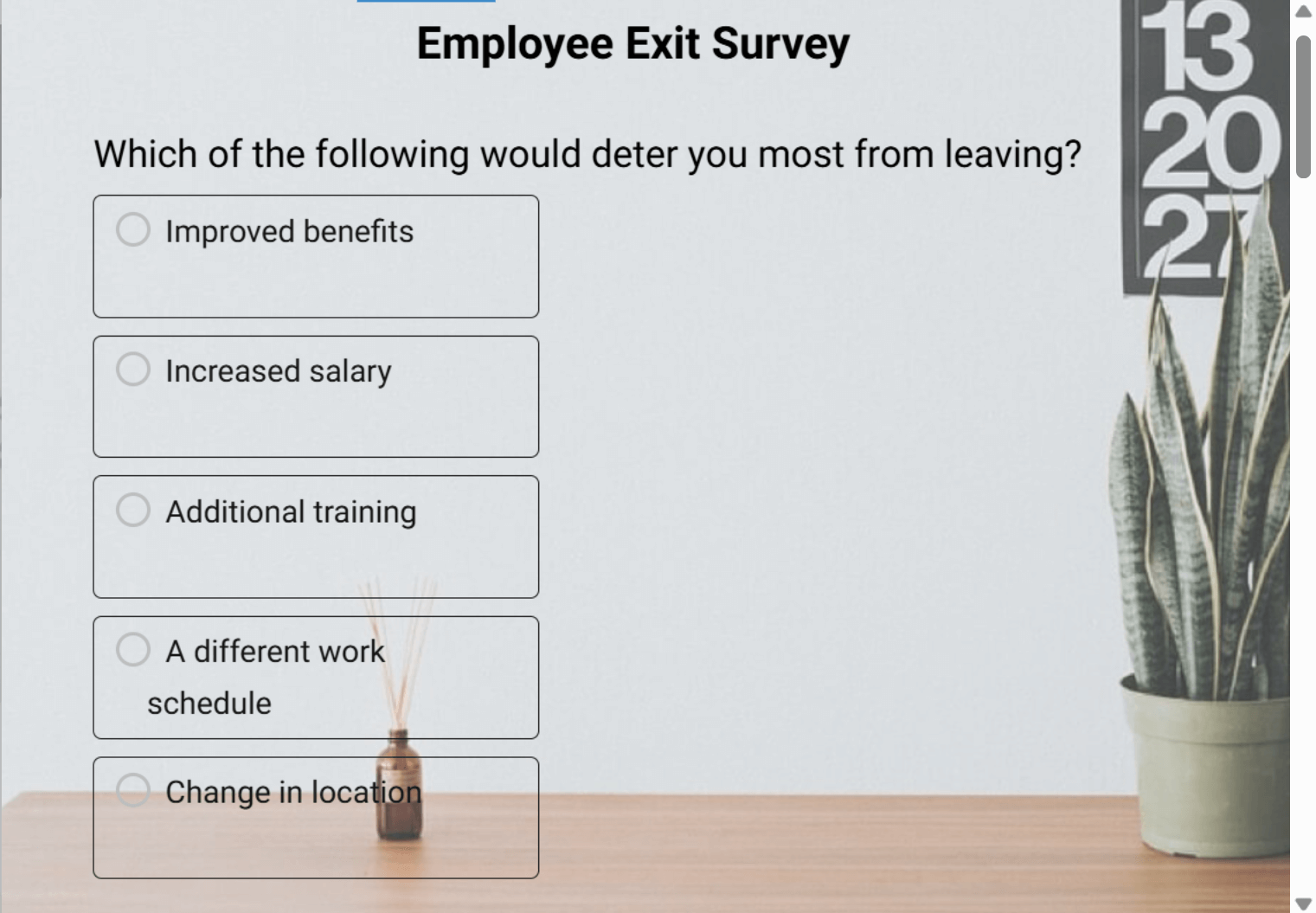
FREE. All Features. FOREVER!
Try our Forever FREE account with all premium features!
How To Actually Put These Retention Strategies Into Motion
Reading a list of strategies is one thing. Turning them into a working system is another. Retention improves when you have consistent signals from your employees, a way to act on those signals, and tools that support people’s growth day to day.
Here’s the simplest way to operationalize everything you just learned.
1. Start by Listening to Your Team the Right Way
You cannot fix what you cannot see. Your first move is to run a clean, anonymous survey that tells you where people are struggling. This is where a structured tool helps. Build the survey inside tools like ProProfs Survey Maker, turn on the anonymity toggle, and use the AI builder if you want help drafting clear questions without starting from scratch. A solid survey shows you which of the 14 strategies matter most for your team right now, whether it is pay, growth, burnout, or management issues.
Here’s a quick video to learn how to create surveys:
2. Use Pulse Checks and Microfeedback to Stay Ahead of Problems
A yearly survey gives you direction, but pulse checks keep you from flying blind in between. Drop one or two question nudges through tools like Qualaroo so you can track morale, workload, or communication friction without overwhelming people. These micro signals help you adjust early, long before a resignation lands on your desk. Here’s a video to see it in action:
3. Turn Insights Into a Real Plan, Not Another Slide Deck
Once you know the hotspots, pick the two or three retention levers that will move the needle fastest. Maybe it is manager training. Maybe it is workload balance. Maybe it is clearer growth paths. Document your plan, assign owners, and communicate the changes so employees see the loop closing. Retention improves when people see momentum, not promises.
4. Build Growth Into the System With Continuous Learning
You can talk about development all day, but people stay when growth is built into the workflow. This is where an Employee Learning Suite becomes useful. Give employees access to courses, role-specific training, and clear skill paths, so they can see their future within the company instead of elsewhere. This ties directly into Strategy 5: if you want people to stay, you have to help them grow.
5. Create a Monthly Rhythm That Makes Retention Automatic
Retention dies when it is treated as a one-off project. Set a simple monthly routine: review survey signals, check progress on your action plan, run a quick pulse if needed, unblock managers, and highlight small wins. Tools can help, but it’s the rhythm that builds trust.
6. Re-measure Every Quarter to Stay Honest
Improvement only sticks if you keep score. Run a quarterly pulse or a shorter satisfaction survey to see what actually changed. If burnout drops or manager feedback improves, double down. If something stalls, adjust fast. Retention becomes predictable once you start treating feedback as an operating system, rather than an event.
Why Retention Matters
Retention isn’t just about keeping turnover numbers low. It’s about protecting the very foundation of your company. Every time an employee leaves, you lose more than a headcount; you lose institutional knowledge, team cohesion, and momentum.
The financial costs of recruiting and training replacements are apparent, but the cultural costs are often greater. Morale dips, productivity slows, and even customer experience suffers when teams are constantly in a state of flux.
Frameworks like Herzberg’s Two-Factor Theory remind us that retention depends on both hygiene factors (such as pay, conditions, and policies) and motivators (such as growth, recognition, and purpose). Neglect either side, and people will leave. Retention is not a soft metric. It is a growth strategy that directly impacts your bottom line and your ability to scale.
Retention Is Built, Not Bought
Employee retention does not come from one program or perk. It comes from a culture where people feel valued, supported, and connected to something bigger than themselves. The strategies we have covered are not quick fixes; they are commitments.
A mix of tools like ProProfs Survey Maker and others, like LMSs, can help you run the systems behind those commitments, but the intent still has to come from leadership.
Retention is less about keeping people from leaving and more about giving them reasons to stay. Every conversation, every policy, every decision either strengthens or weakens that bond. The companies that win are the ones that choose to strengthen it, day after day.
Frequently Asked Questions
What are the 3 R's of employee retention?
The 3 R’s of employee retention are respect, recognition, and reward. Employees remain loyal when they feel respected as individuals, recognized for their contributions, and rewarded in ways that matter. These principles are simple but powerful, reminding leaders that appreciation and fairness are essential to building long‑term commitment.
What are retention techniques?
Retention techniques are practical methods organizations use to keep employees engaged and committed. These include offering competitive pay, providing career development opportunities, fostering a positive work environment, promoting work-life balance, and recognizing individual contributions. Practical techniques are not one-time fixes, but ongoing practices that demonstrate to employees that their growth and well-being matter.
What are the three most important factors for employee retention?
The 3 most important factors for employee retention are competitive compensation, career development, and work‑life balance. Employees stay when they feel fairly rewarded, see opportunities to grow, and can sustain their energy without burning out. These elements form the foundation of retention, ensuring people feel secure, motivated, and supported.
What is the role of leadership in employee retention?
Leadership plays a decisive role in whether employees stay or leave. Visible, accessible leaders build trust and connection, while poor leadership drives disengagement. When leaders communicate openly, model respect, and invest in growth, employees feel valued and supported. Strong leadership is often the hidden engine behind long‑term retention.
FREE. All Features. FOREVER!
Try our Forever FREE account with all premium features!

 We'd love your feedback!
We'd love your feedback!
 Thanks for your feedback!
Thanks for your feedback!







